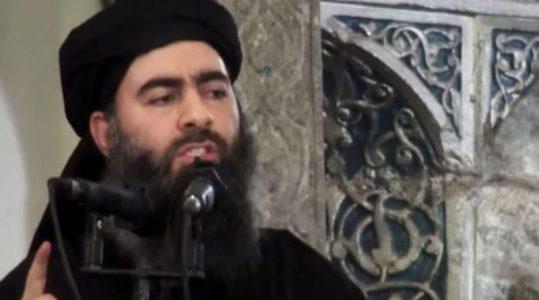
ISIS terrorist group leader believed to have fled coup attempt by his own fighters
The Isis leader, Abu Bakr al-Baghdadi, survived a coup attempt last month launched by foreign fighters in his eastern Syrian hideout, intelligence officials believe, and the terrorist group has since placed a bounty on the main plotter’s head.
The incident is believed to have taken place on 10 January in a village near Hajin in the Euphrates River valley, where the jihadist group is clinging to its last sliver of land. Regional intelligence officials say a planned move against Baghdadi led to a firefight between foreign fighters and the fugitive terrorist chief’s bodyguards, who spirited him away to the nearby deserts.
Isis has offered a reward to whomever kills Abu Muath al-Jazairi, believed to be a veteran foreign fighter, one of an estimated 500 Isis fighters thought to remain in the area. While Isis did not directly accuse Jazairi, placing a bounty on the head of one of its senior members is an unusual move and intelligence officials believe he was the central plotter.
“They got wind of it just in time,” an intelligence official said. “There was a clash and two people were killed. This was the foreign fighter element, some of his most trusted people.”
Iraqi officials and their counterparts in Britain and the US are confident that Baghdadi has recently spent time in the final redoubt of the so-called caliphate, where the group’s diehard members have regrouped after two years of battlefield losses for what has widely been billed as a last stand.
The holdouts include senior leaders and the remnants of the ranks of foreign fighters who flooded into Syria and Iraq from 2013-15, swelling the ranks of the extremist organisation to at least 70,000. Now, an estimated 500 or so militants remain, along with their families, hemmed in by US-backed Kurdish forces on the Syrian side of the Iraqi border, and by Iranian-backed Shia militias on the other.
As Isis’s area of control has disintegrated and its leaders have been annihilated, Baghdadi’s whereabouts have become an increasing focus. A diabetic with high blood pressure, who suffered permanent injury in an airstrike four years ago, he has been on the run from the militaries of four nation states as well as tens of thousands of militia since his only public appearance to anoint himself as caliph in the al-Nuri mosque in Mosul in mid-2014.
While rumours of unrest within the dwindling organisation have swirled in recent months, there has been little – until now – to suggest a serious threat from within to Baghdadi’s leadership or life. Those who have stayed near the extremist leader are themselves also ideologically driven veterans, whose loyalty has been tested over years of losses. However, Isis fighters – among them former diehards – have been fleeing the besieged areas each day for the past three weeks, with several thousand members and their families surrendering to Kurdish-led forces near Deir ez-Zor.
Among the new captives are large numbers of foreigners, some of whom insist they were forced further into the group’s shrinking lands by months of hectic attacks. Kurdish forces believe that foreigners remain clustered around the remnants of the Isis leadership. Several captives are believed to be among them – including the British journalist John Cantlie, who was one of more than 25 foreigners held by Isis in Raqqa.
Cantlie was captured by Isis in Syria in 2012 and subsequently fronted a series of propaganda videos for the group. He has not been seen since the last video was last released in 2016, but earlier this week the UK security minister, Ben Wallace, in a briefing with reporters, said he believed Cantlie was still alive. Reports on Thursday suggested Isis could be using Cantlie and other western hostages still unaccounted for as bargaining chips in return for safe passage out.
Kurdish forces, and intelligence officials in Iraq, estimate that the remnants of the group have enough weapons and personnel to survive for at least another month, if they choose to hold firm. Fighters have an escape route, of sorts, to the deserts, but Syrian regime and Russian forces are active to the south of that area, making a dash into the sands a tricky proposition.
Roads to the frontlines remain littered with the ruins of recent clashes: buildings pancaked by bombsand oilfields ransacked for parts. Roads leading to the Syrian border have been gouged by the retreating extremists who – even in the depths of winter – are sustaining a furious rearguard action.
Despite Isis’s losses of land, there are growing signs of a low-level insurgency re-emerging in Iraq, near where the group overran Mosul in June 2014. The numbers of roadside bombs and summary executions have steadily increased over the past year, officials in northern Iraq say. And Isis is believed to have raised its flag – albeit briefly – in parts of Mosul and the nearby Nineveh plains.
Source: Guardian





